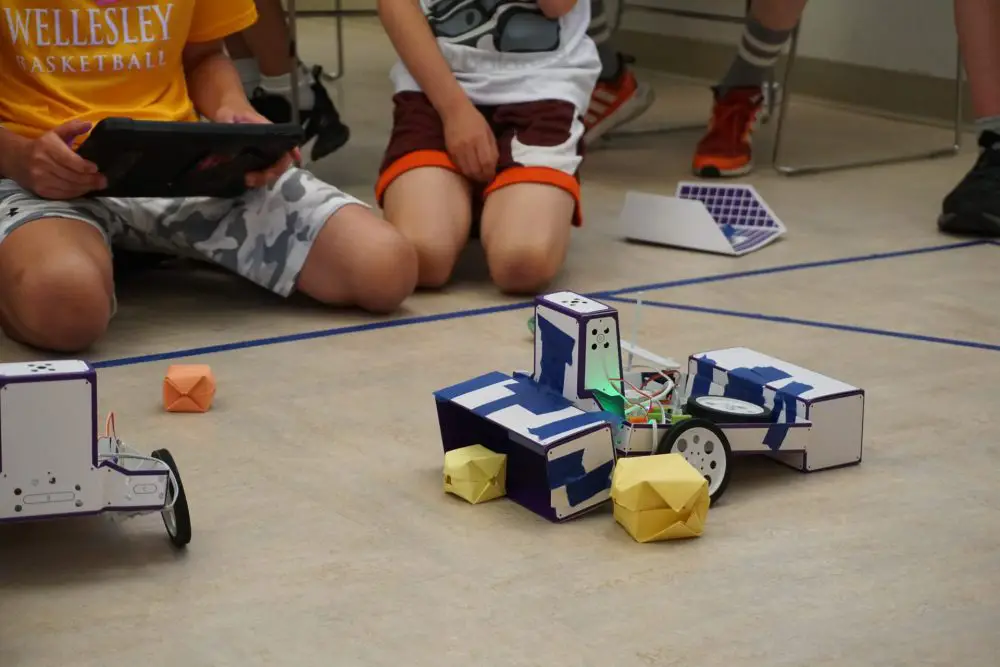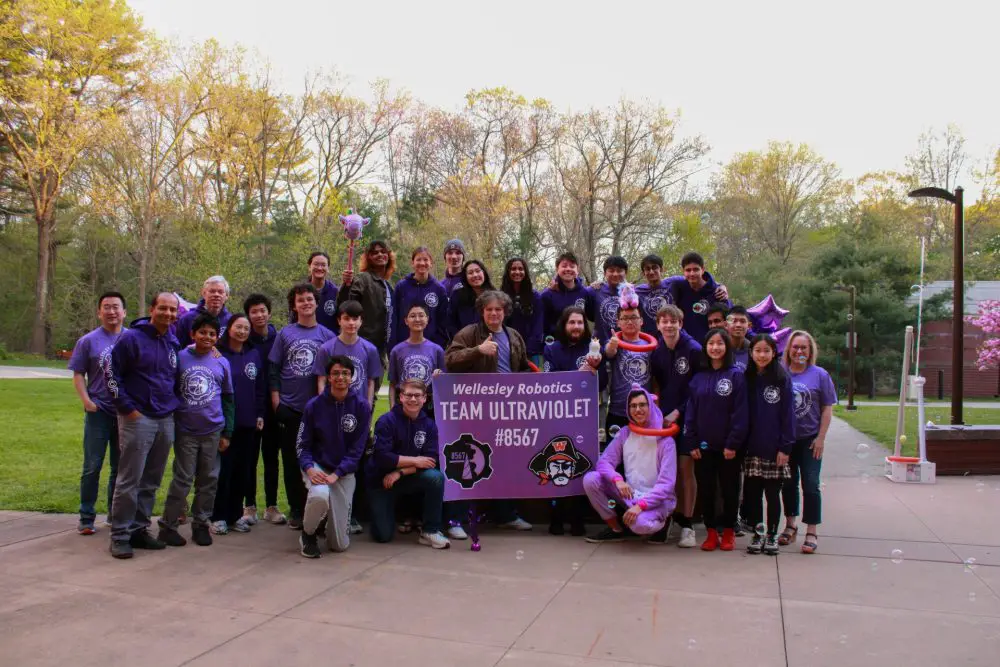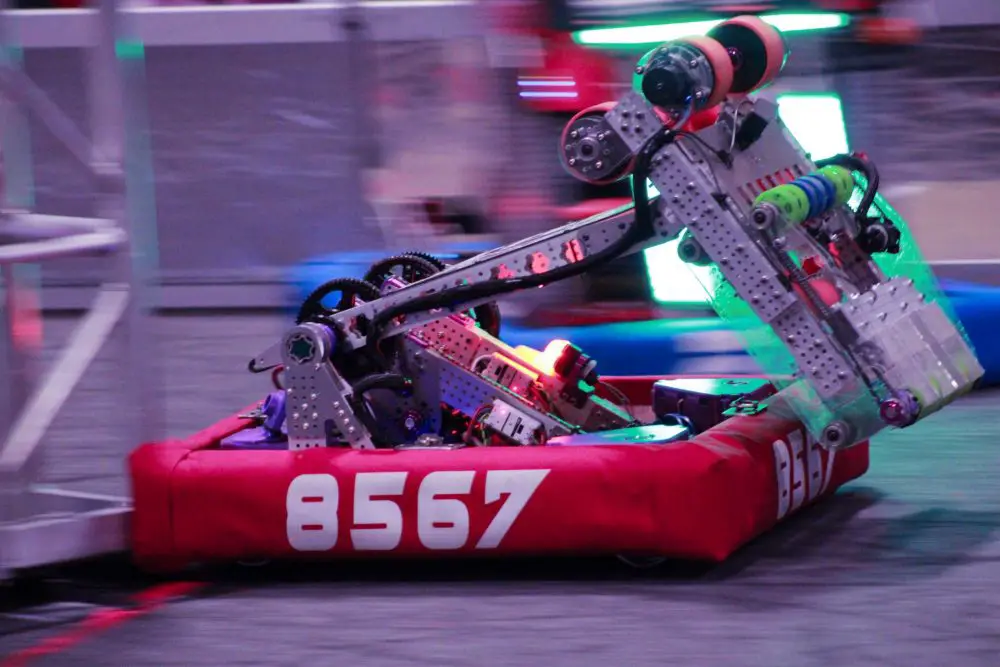Wellesley High’s Team Ultraviolet robotics club feeling more at home
When we first wrote a few years back about Wellesley High School’s Team Ultraviolet, a FIRST (For Inspiration and Recognition of Science and Technology) club, most of the non-competition action took place at the garage of team member’s home. But with that student since graduated and the space becoming unavailable next year, the club has been looking to transition to the high school building itself for more of its activities.
“This year we are pushing to make our new home in Wellesley High School,” writes Neha Guruprasad, who responded to our questions with fellow club members John Brosnahan, Alexis Lee, and Stephanie Xia. “Wellesley Public Schools have graciously provided operational funding for our team for the past few years, but we are looking for a new workspace… Fitting an entire robot manufacturing and storage space into a high school has definitely proven to be challenging, however, we have made some progress.”
The club has been working to increase the portability of its build space to facilitate transport to the high school. It’s also trying to hold as many robot sessions at the high school as possible. “In addition to improving our team sustainability, transitioning into the high school will allow for more convenient sessions for our members and greater integration with the Wellesley Public School system,” the team says.
Busy summer
Team Ultraviolet comes off a busy summer of teaching youngsters about robotics.
The high schoolers have held robotics workshops and demonstrations for kids since 2021, following the club’s founding in 2020. This past summer marked the second year of teaching Space Rover Robotics at the Recreation Center, and Team Ultraviolet also runs a FIRST Lego League (FLL) for middle school students. “Our FLL teams also serve as a pipeline to our [FIRST Robotics Competition] team to ensure our sustainability!” says Guruprasad, the team’s Impact Lead (this entails coordinating efforts to make a positive impact on the community by raising awareness and accessibility of STEM education, such as through legislative efforts).

About 10 Team Ultraviolet members taught more than 40 4th-6th graders this past summer in 3-hour sessions that included snack and free play time. “Students learn how electrical circuits work, what NASA Mars rovers do, and design and build their own mini-rovers in pairs. Then they get to operate their rovers in teams to play games, similar to what we do with our robot in FIRST Robotics Competitions during the school year. On the final day of the workshops, the students get to meet and operate our 125 lb competition robot, which they always find very exciting!” Team Ultraviolet says.
While it’s challenging to keep the attention of younger kids, Guruprasad says months of planning and a focus on hands-on learning ensured kids were engaged and had fun. Problem solving challenges for younger kids, and engineering designs and modifications for more experienced ones, were among the highlights.
“One big takeaway for us has been that every child is unique, and by connecting with each one as an individual, we are best able to help cultivate their curiosity and allow them to flourish. Our 3:1 or lower mentor-to-student ratio allows us to give each child the attention that they need. We’ve also learned that it’s best to pair students in groups based on age and experience so that every kid can learn new concepts and not repeat ones they may already be familiar with,” the team says, noting that some kids come in having used programs like Scratch.
New season for Team Ultraviolet
Team Ultraviolet by early October had nearly four dozen members and that number is expected to grow as the school year moves ahead.
“Team sustainability is a big theme for us this year… We welcome all students to our team, including those who might not typically see themselves in STEM,” according to the team. “In addition to the technical aspect of designing and constructing a robot, our team has a large administrative wing that manages everything from logistics to outreach to workshops to social media. We not only want to recruit new students, but mentors as well, as we would love to find more WPS staff mentors to advise us. We also need to raise funds to build our competition robot. These workshops work as fundraisers, and we also have a GoFundMe where anyone can donate to our nonprofit team.”

Team Ultraviolet is currently in its preseason, which is followed by the build season. Preseason includes member recruitment, writing grants to raise money for robot parts, and starting on projects and workshops where skills from soldering to programming are learned and put to use. The software subteam, for example, will reprogram the robot named “Conehead” from last year, while the mechanical subteam will repair damages to the robot from two years ago.
“Since we don’t know the rules of the game we will be competing in during this time, preseason works to train members to start working on the robot once the rules are announced,” the team says.
January marks the start of the build season with Kickoff, during which FIRST Robotics announces the year’s game challenge to all teams worldwide. That’s when the brainstorming really begins for Team Ultraviolet, which aims to have a solidified robot design within a couple of weeks.
Members then spend six weeks constructing the robot, which will be used in competitions vs. other New England high school teams in late February into April.
“During each competition, we compete in matches on teams, called alliances, which consist of three randomly selected robots. Each alliance must complete a task, such as placing cubes and cones, balancing on a seesaw, or shooting baskets, depending on what the game is that year. After each game, the alliance with the most points wins that match, contributing to each team’s overall rankings. In between matches and competitions, we can make repairs or improvements to our robots to ensure our robot is the best it can be,” Team Ultraviolet explains.
The club isn’t all about competitions. In the spirit of community outreach, it runs demos for organizations such as Girl Scout troops, and takes part in activities like the Annual Veterans Parade during Wellesley’s Wonderful Weekend.

Have questions for the team or want to help? Contact Team Ultraviolet at wellesleyfrc@gmail.com
You can also follow their adventures on Instagram.